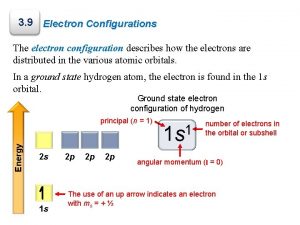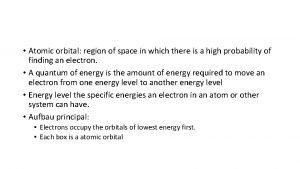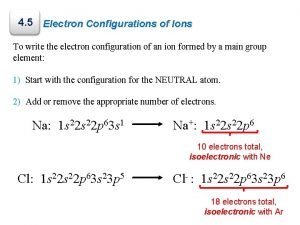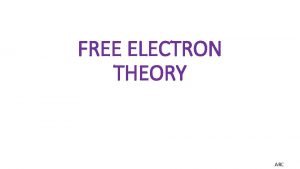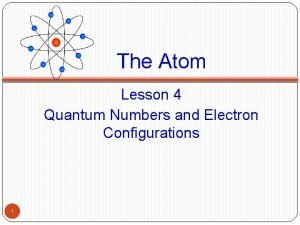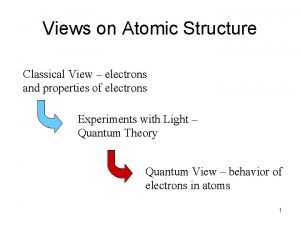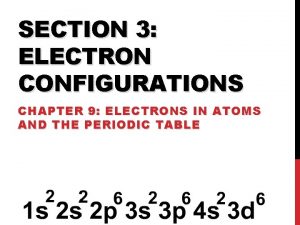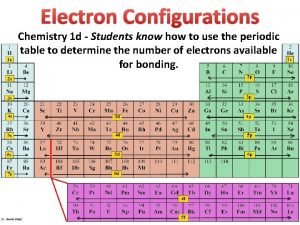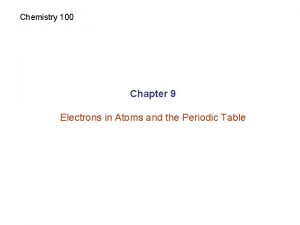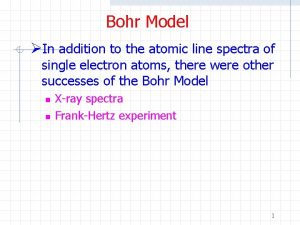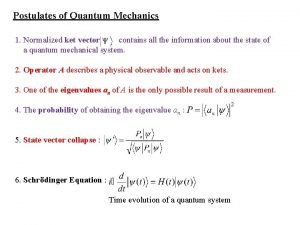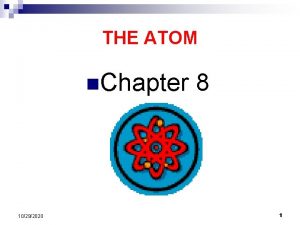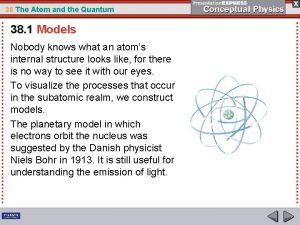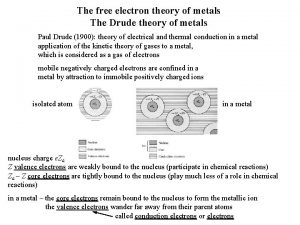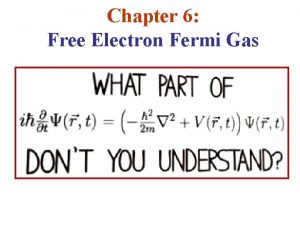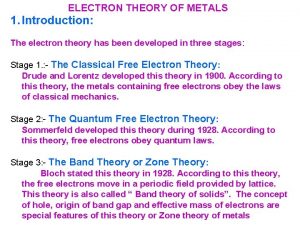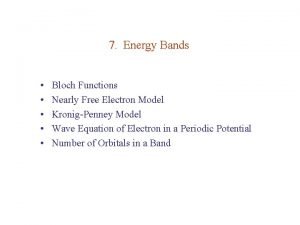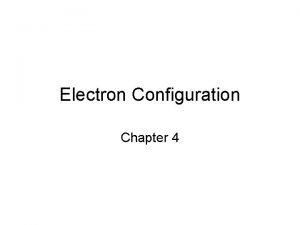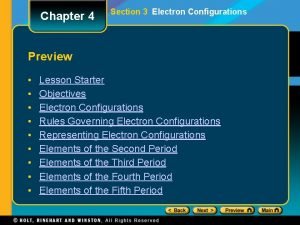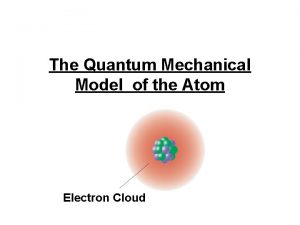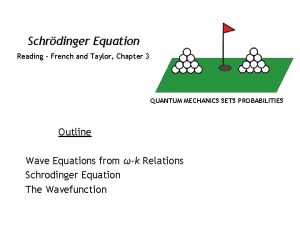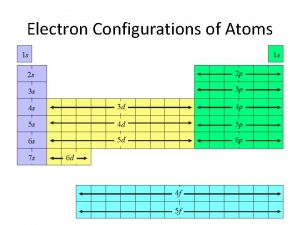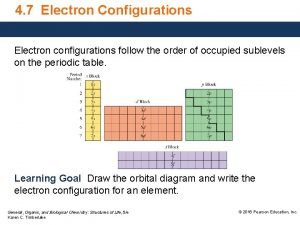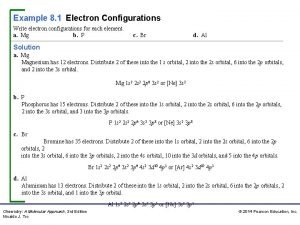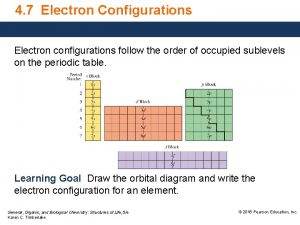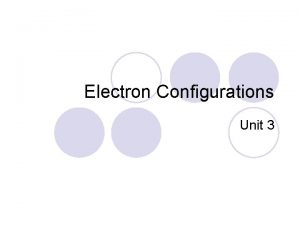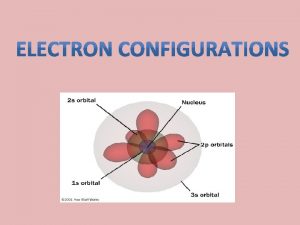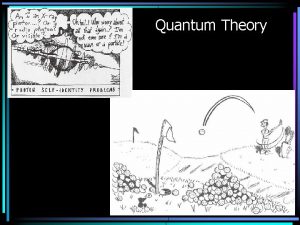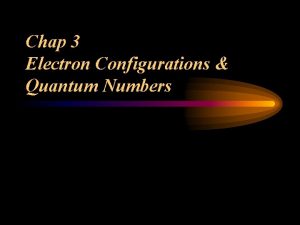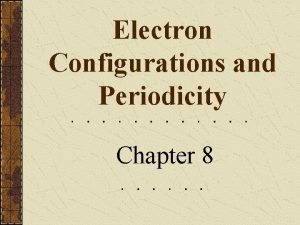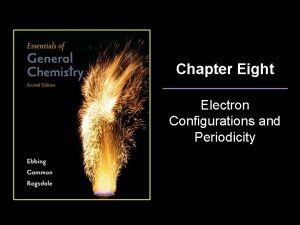Chapter 5 Quantum Theory and Electron Configurations QuantumMechanical













































- Slides: 45

Chapter 5

Quantum Theory and Electron Configurations

Quantum-Mechanical Model of the Atom • Since the Bohr model had a very limited use, a new and very different model of the atom exists • The Quantum Mechanical Model (1926) contains: F Quantum energy levels F Dual wave/particle nature of electrons F Electron clouds • In the new model, don’t know exactly where electrons are - only know probabilities of where they could be

Heisenberg Uncertainty Principle • Heisenberg Uncertainty Principle = impossible to know both the velocity (or momentum) and position of an electron at the same time

The Quantum Mechanical Model Chapter 5

Quantum Mechanical Model • Einstein (1905) F Light consists of quanta, called photons F Photoelectric Effect – Sunlight striking a sheet of metal will knock off the outermost electrons and move, causing an electric current • de Broglie (1924) = Photons both particles and waves • Davisson (1927) = Electrons both particles and waves

Quantum-Mechanical Model of the Atom • Orbital = region around nucleus where an electron with a given energy level will probably (90%) be found • Four kinds of orbitals F s - spherical in shape, lowest orbital for every energy level F p - dumbbell shaped, second orbital F d - complex “flower” shape, third orbital F f - very complex shape, highest orbital

s-orbitals • All s-orbitals are spherical. • As n increases, the s-orbitals get larger.

p- orbitals • Three p-orbitals: px, py, and pz F Lie along the x-, y- and z- axes of a Cartesian system. F Dumbbell shaped, gets larger as n increases

d and f - orbitals • There are five d and seven f-orbitals.


Quantum Mechanical Model • Principle Energy Levels (n) F Labeled from 1 -7 F First energy level is n=1 F Contains sublevels (s, p, d and f) • Each energy level contains the number of sublevels equal to it’s value for n – If n=3, there are three sublevels

Quantum Mechanical Model • In each sublevel there atomic orbitals • Atomic orbitals – describe a space where an electron is likely to be found Type of subshell Shape of orbitals Number of orbitals Orbital ‘names’ s Spherical 1 s p Dumbbell 3 px, py, pz d Cloverleaf (and one donut) 5 f Multi-lobed 7

Quantum Mechanical Model • Each orbital can contain two electrons. • Since negative-negative repel, these electrons occupy the orbital with opposite spins.

Quantum Mechanical Model • The total number of orbitals of an energy level is n 2. F For the third principle energy level, n=3, which means there are 9 orbitals • These orbitals are 3 s, 3 px, 3 py, 3 pz and the 5 d orbitals • Remember, we no longer think of orbitals as concentric circles, but we can say that n=4 extends farther from the nucleus than n=1.

Valence Electrons • Only those electrons in the highest principle energy level

Electron Configuration and Orbital Notation • Aufbau Principle – electrons fill lower energy orbitals first, “bottom-up” F n=1 fills before n=3 Energ y • Will an electron fill the 1 s or the 2 s orbital first? 2 s 1 s 2 px 2 py 2 pz

Electron Configuration &Orbital Notation • Hund’s Rule – electrons enter same energy orbitals so that each orbital has one electron before doubling up F Each of the first electrons to enter the equal energy orbitals must have the same spin Energ y F If we have 7 electrons, how will they fill in the below orbitals? 2 s 1 s 2 px 2 py 2 pz

Electron Configuration and Orbital Notation • Pauli Exclusion Principle – an orbital can contain no more than 2 electrons. Electrons in the same orbital must have different spins. Energ y • If we have 8 electrons, how will they be arranged? 2 s 1 s 2 px 2 py 2 pz




Apartment Analogy • • Atom is the building Floors are energy levels Rooms are orbitals Only two people per room

Orbital Diagrams • Draw each orbital as a box. • Each electron is represented using an arrow. F Up arrows – clockwise spin F Down arrows – counter-clockwise spin • Determine the total number of electrons involved. • Start with the lowest energy level (1 s) and start filling in the boxes according the rules we just learned.

Transition Metal Exceptions • Can move from the highest filled s orbital to create a fully filled, or half filled d or f • TRANSITION METAL EXCEPTIONS

Total # of electrons in an Energy Level • 2 n 2 • n=1 2 x 12 + = 2 • n=2 2 x 22 + = 8 • n=3 2 x 32 + = 18 • • n=4 n=5 n=6 n=7 Chapter 5

Orbitals and Energy Levels Principal Sublevels Energy Level Orbitals n=1 1 s 1 s(one) n=2 2 s, 2 p 2 s (one) + 2 p (three) n=3 3 s, 3 p , 3 d 3 s (one) + 3 p (three) + 3 d (five) n=4 4 s, 4 p, 4 d, 4 f 4 s (one) + 4 p (three) + 4 d (five) + 4 f (seven) Chapter 5

Summary # of Max shapes electrons s p d f Chapter 5 Starts at energy level

Orbitals and Energy Levels n=4 Increasing energy n=3 n=2 n=1 1 s 2 p 2 s 3 d 3 p 3 s 4 f 4 d 4 p 4 s and so on. .

Orbital Diagrams • Orbital diagrams are used to show placement Li of electrons in orbitals. • Need to follow three rules Be (Aufbau, Pauli, Hund’s) B to complete diagrams C N Ne Na

Orbital Diagram 4 p 3 d Energy 4 s 3 p 3 s 2 p 2 s 1 s

Electron Configuration • Let’s determine the electron configuration for Phosphorus • Need to account for 15 electrons Chapter 5

Increasing energy 7 s 6 s 5 s 4 s 3 s 2 s 7 p 6 p 6 d 5 d 5 p 4 d 4 p 3 d 3 p 2 p 1 s Chapter 5 5 f 4 f

Increasing energy 7 s 6 s 5 s 4 s 3 s 2 s 7 p 6 p 6 d 5 d 5 p 4 d 4 p 3 p 2 p 3 d • The first to electrons go into the 1 s orbital • Notice the opposite spins • only 13 more 1 s Chapter 5 5 f 4 f

Increasing energy 7 s 6 s 5 s 4 s 3 s 2 s 7 p 6 p 6 d 5 d 5 p 4 d 4 p 3 p 2 p 5 f 4 f 3 d • The next electrons go into the 2 s orbital • only 11 more 1 s Chapter 5

Increasing energy 7 s 6 s 5 s 4 s 3 s 2 s 7 p 6 p 6 d 5 d 5 p 4 d 4 p 3 d 3 p • The next electrons go into the 2 p orbital 2 p • only 5 more 1 s Chapter 5 5 f 4 f

Increasing energy 7 s 6 s 5 s 4 s 3 s 2 s 7 p 6 p 6 d 5 d 5 p 4 d 4 p 3 d 3 p • The next electrons go into the 3 s orbital 2 p • only 3 more 1 s Chapter 5 5 f 4 f

Increasing energy 7 s 6 s 5 s 4 s 3 s 2 s 1 s 7 p 6 p 6 d 5 d 5 p 5 f 4 d 4 p 3 p • 2 p • • • 3 d The last three electrons go into the 3 p orbitals. They each go into separate shapes 3 unpaired electrons 1 s 22 p 63 s 23 p 3 Chapter 5 4 f

Writing Electron Configuration • Determine the total number of electrons. • Write the principle energy level number as a coefficient, the letter for the subshell, and an exponent to represent the number of electrons in the subshell. • He: 1 s 2

The Kernel (Noble Gas) Notation • Determine the total number of electrons • Find the previous noble gas and put its symbol in brackets • Write the configuration from that noble gas forward as usual

Writing electron configurations • Examples • • • O Ti Br • Core format • • • O Ti Br 1 s 2 2 p 4 1 s 2 2 p 6 3 s 2 3 p 6 3 d 2 4 s 2 1 s 2 2 p 6 3 s 2 3 p 6 3 d 10 4 s 2 4 p 5 [He] [Ar] 2 s 2 2 p 4 3 d 2 4 s 2 3 d 10 4 s 2 4 p 5 Chapter 5


Quantum Numbers • Each electron can be described by four numbers unique to that electron (like a fingerprint) • “n” – the principal quantum # describes the principal energy level, n=1, 2, 3…, 7 • “l” – describes the shape of subshell F s subshell = 0 F p subshell = 1 F d subshell = 2 F f subshell = 3 • “m” –describes the orientation , m = -l…. 0…. +l • “s” – describes the spin, s=1/2 or -1/2


Quantum Numbers • Example: Look at carbon’s orbital diagram which contains 6 electrons. What are the quantum #s for the last electron to be filled? • Example: Look at Vanadium’s Kernel notation. Do the orbital diagram for only the valence electrons. What are the quantum #’s for the second to last electron to be filled?
 Electronic configurations
Electronic configurations Excited state electron configuration
Excited state electron configuration Stable electron configurations are likely to contain
Stable electron configurations are likely to contain Ccechs
Ccechs Stable electron configurations are likely to contain
Stable electron configurations are likely to contain Dot
Dot Stable electron configurations
Stable electron configurations Drawbacks of classical free electron theory of metals
Drawbacks of classical free electron theory of metals Quantum numbers and electron configuration
Quantum numbers and electron configuration E=h x v
E=h x v Quantum physics vs quantum mechanics
Quantum physics vs quantum mechanics Quantum physics vs quantum mechanics
Quantum physics vs quantum mechanics Dxy orbital shape
Dxy orbital shape 4p7 electron configuration
4p7 electron configuration Quantum mechanical model definition
Quantum mechanical model definition Chapter 27 quantum theory answers
Chapter 27 quantum theory answers Rigid vs flexible pavement
Rigid vs flexible pavement Icq transistor
Icq transistor What do you mean by electronic configuration?
What do you mean by electronic configuration? Electrons configurations
Electrons configurations Electrons configurations
Electrons configurations Electrons configurations
Electrons configurations Bjt regions
Bjt regions Ceedar innovation configurations
Ceedar innovation configurations Electrons in atoms section 2 quantum theory and the atom
Electrons in atoms section 2 quantum theory and the atom Electrons in atoms section 2 quantum theory and the atom
Electrons in atoms section 2 quantum theory and the atom Quantum theory and the electronic structure of atoms
Quantum theory and the electronic structure of atoms Quantum shannon theory
Quantum shannon theory What is the prison program quantum mechanics
What is the prison program quantum mechanics Sommerfeld quantum theory
Sommerfeld quantum theory Normalize vector
Normalize vector Xkcd exponential
Xkcd exponential Quantum theory project
Quantum theory project Quantum theory of light
Quantum theory of light Chapter 38 the atom and the quantum
Chapter 38 the atom and the quantum Drude free electron theory
Drude free electron theory Free electron fermi gas
Free electron fermi gas Basic electron theory
Basic electron theory Drawbacks of free electron theory
Drawbacks of free electron theory Nearly free electron
Nearly free electron Aubfau
Aubfau Section 3 electron configuration
Section 3 electron configuration Physics topic 12
Physics topic 12 What is quantum mechanical model
What is quantum mechanical model Schrodingers cay
Schrodingers cay Kaist nuclear engineering
Kaist nuclear engineering

